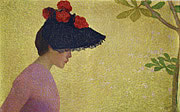
Clothing and Textiles
Clothing and Textiles

#030702 8
Li Bai, also known as Li Bo, of the High Tang period, 701-762. He was one of th...

#03070211
Young nobleman on horseback From China, Yuan dynasty, dated the 27th year of...

#03070216
Monk,pilgrim,accompanied by a tiger (Xuanzang). China,Donhuang,T'ang Dyn...

#03070218
Prince Shotoku Taishi, Japan, Kamakura period, early 14th. He is shown as a 16-...

#03070219
Figure of Aizen Myo-o, Kamakura or Muromachi period, 14th-15th century. Aizen is...

#03070221
Jade ornament, Eastern Zhou period, 5th century BC. These four discs of jade wer...

#03070226
Liubo players found in eastern China, Han dynasty, 1st-2nd century. The figures...

#03070244
Copy of an idol venerated in the Temple of the Five Hundred Genii in Canton, Chi...

#03070249
Country doctor applying a painful cure of moxibustion (traditional Chinese medic...

#03070250
On the River at Qing Ming Festival. This painting is considered one of the most...

#03070251
Buddha. Painted wood sculpture; Muromachi period, 16th century CE.

#03070253
Tsuba (round guard at the end of the grip of a sword) in shape of a serment. Edo...